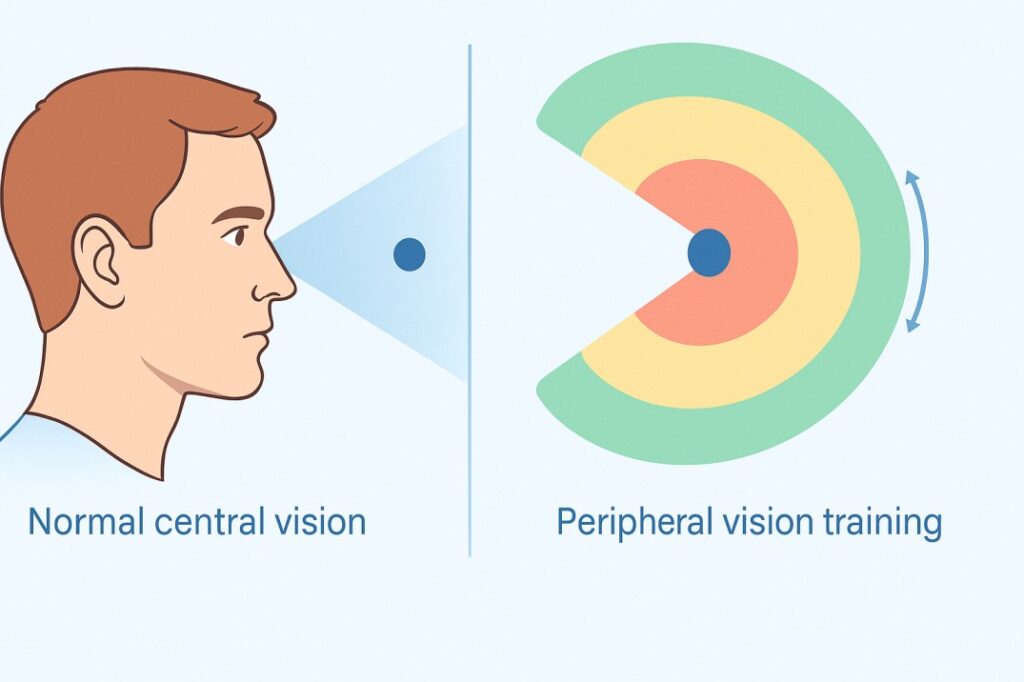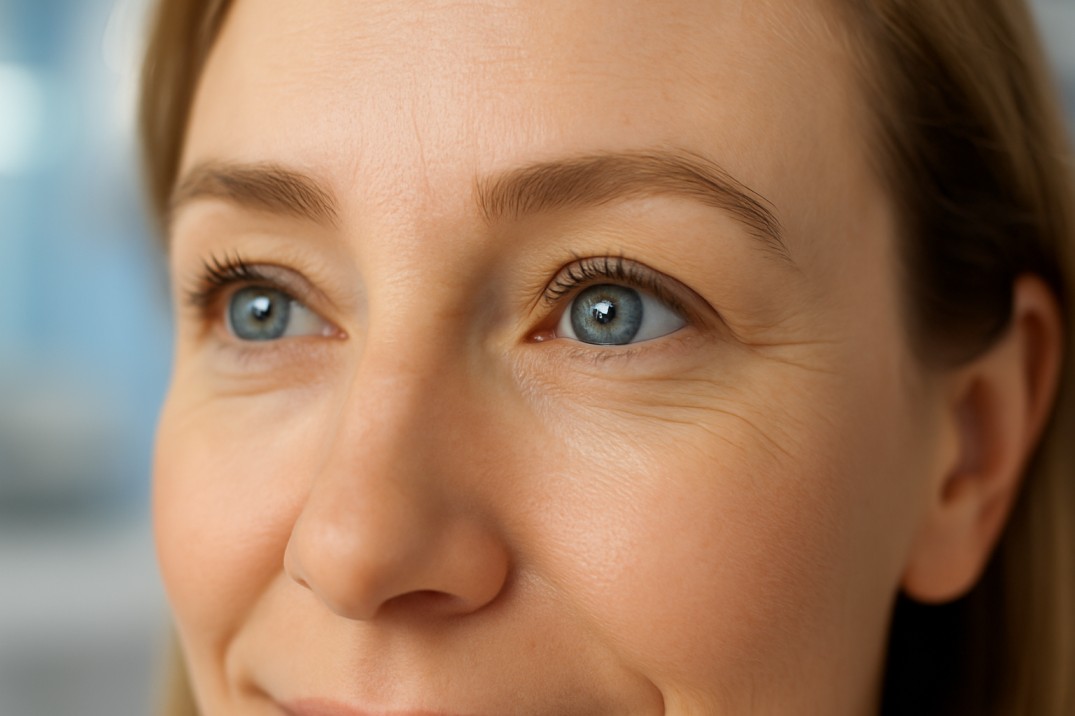Peripheral Vision in Athletes Training | Cannon EyeCare Seattle
Bottom Line Up Front: Peripheral vision in athletes is a game-changing skill that can significantly improve reaction times and spatial awareness, while proper eye protection can prevent up to 90% of sports-related eye injuries. At Cannon EyeCare, we help athletes at every level enhance their visual performance through evidence-based peripheral vision training and expert eye care.
Understanding Peripheral Vision in Athletic Performance
Peripheral vision represents the area of sight occurring outside your direct line of focus—everything you can see without moving your head or eyes. For athletes, peripheral vision in athletes serves as an early warning system that processes information faster than central vision, making it crucial for split-second decisions that determine victory or defeat.
What makes peripheral vision special for athletes? Unlike central vision, which handles detailed processing and object identification, peripheral vision in athletes excels at detecting motion, changes in the environment, and spatial relationships. In fast-paced sports, this translates to spotting an open teammate, avoiding an oncoming defender, or reacting to unexpected plays before they fully develop.
Learn more about comprehensive eye exams for athletes and sports vision training programs at our Seattle locations.
The Science Behind Athletic Vision
Recent research from the International Review of Sport and Exercise Psychology reveals that up to 80% of visual information in fast-paced sports comes from peripheral awareness. This isn’t just passive background vision—it actively coordinates with your brain to guide body movements and strategic decisions.
Athletes with superior peripheral vision demonstrate several key advantages:
- Enhanced spatial orientation and balance – Critical for maintaining position during dynamic play
- Faster reaction times to environmental changes – Process peripheral information up to 25% quicker
- Improved anticipation of opponent movements – Detect threats before they develop
- Better field awareness across all sports – Monitor multiple players simultaneously
- Reduced risk of collision-related injuries – Early warning system for incoming contact
Discover how Seattle sports vision specialists can evaluate and enhance these crucial abilities.
The Connection Between Peripheral Vision and Sports Performance
Professional athletes have long understood the competitive edge that superior peripheral vision provides. Wayne Gretzky’s legendary ice awareness, which many attribute to exceptional peripheral vision in athletes, allowed him to “see” plays develop before they happened. Similarly, elite basketball players use peripheral awareness to track multiple players simultaneously while maintaining focus on the ball.
Sport-Specific Applications
Basketball and Soccer: Players need constant awareness of teammate positioning, opponent movements, and open spaces. Strong peripheral vision enables quick passes and prevents turnovers.
Football: Quarterbacks scan the field for open receivers while monitoring pass rushers. Running backs use peripheral awareness to spot holes in the defense and avoid tackles.
Tennis and Racquet Sports: Players track the ball trajectory with central vision while using peripheral awareness to position themselves and anticipate opponent shots.
Baseball and Softball: Batters track fast-moving pitches while maintaining awareness of base runners and fielding positions.
Combat Sports: Fighters rely on peripheral vision to detect incoming attacks from multiple angles and maintain spatial awareness in the ring.
Hockey and Fast-Paced Sports: Players navigate at high speeds while tracking pucks, teammates, and opponents simultaneously.
Schedule a sport-specific vision assessment to identify your unique visual training needs.
How Cannon EyeCare Enhances Athletic Vision in Seattle
At Cannon EyeCare, we understand that superior athletic performance starts with a comprehensive eye health assessment and specialized sports vision training. Peripheral vision in athletes is a critical component that we evaluate and enhance through our Seattle locations in University Village and Pike Place Market, which offer cutting-edge diagnostic technology combined with the personal attention that sets us apart from chain providers.
Why Seattle Athletes Choose Cannon EyeCare:
- Convenient locations near major athletic facilities and universities
- State-of-the-art sports vision testing equipment
- Personalized training programs tailored to the Pacific Northwest sports
- Insurance acceptance for most major Seattle-area health plans
- Flexible scheduling for busy athletic training schedules
Comprehensive Sports Vision Evaluation
Our thorough examination process includes:
- Peripheral vision field testing to establish baseline measurements and identify deficits
- Dynamic visual acuity assessment for moving object tracking at game speeds
- Depth perception and binocular coordination testing for accurate spatial judgment
- Eye movement and tracking evaluation to assess saccadic and pursuit movements
- Sport-specific visual skill assessment customized to your athletic discipline
- Comprehensive eye health screening to detect conditions that may impact performance
Book your comprehensive sports vision evaluation at our University Village or Pike Place Market locations.
Personalized Training Programs
Based on your evaluation results and sport requirements, Cannon EyeCare develops customized peripheral vision training programs that include:
Technology-Enhanced Training: Light board exercises with LED stimulation to challenge peripheral detection and response speed.
Sport-Specific Drills: Wall target exercises, dual-task training, and color recognition drills tailored to your athletic discipline.
Progressive Skill Development: Structured programs that gradually increase complexity while building visual awareness and reaction time.
Performance Monitoring: Regular assessments track improvement and adjust training protocols for optimal results.
Integration Support: Coordination with coaches and trainers to incorporate vision skills into sport-specific practice.
Learn about our customized training programs designed specifically for Seattle-area athletes.
Evidence-Based Training Techniques for Athletes
Professional Training Methods
Light Board Training: Advanced LED systems challenge athletes to maintain central focus while responding to peripheral stimuli. This technology, used by professional sports teams, improves reaction time and decision-making speed.
Strobe Training: Intermittent visual occlusion forces the visual system to work more efficiently, enhancing peripheral awareness and processing speed. Research shows this method can improve visual-motor skills significantly.
Virtual Reality Applications: Immersive VR environments provide controlled settings for peripheral vision training while simulating real-game scenarios.
At-Home Exercise Options
These exercises can supplement professional training but should not replace comprehensive evaluation and guidance from qualified sports vision specialists:
Wall Ball Drill: Stand two feet from a wall, focus on a fixed point at eye level, then throw a ball against the wall using alternating hands while maintaining central focus. Start with 30 seconds, and gradually increase duration.
Awareness Training: Practice identifying objects in your peripheral field without moving your head, gradually expanding your range of detection. Use colorful objects placed at increasing distances from the center of focus.
Finger Wiggle Exercise: Hold hands at temple level and wiggle fingers while maintaining forward focus, slowly moving hands to challenge peripheral boundaries. Progress by adding complexity with different finger patterns.
Sports-Specific Drills: Incorporate peripheral awareness into your regular practice routines, such as dribbling while tracking multiple objects or maintaining field awareness during conditioning.
For personalized exercise programs and proper technique guidance, contact our sports vision specialists in Seattle.
The Role of Professional Eye Care in Athletic Performance
Why Regular Eye Exams Matter for Athletes
The American Optometric Association recommends annual comprehensive eye exams that include peripheral vision testing for all athletes. These evaluations can detect vision problems that may limit performance and identify opportunities for enhancement through targeted training.
Early Detection Benefits:
- Identify vision deficits before they impact performance or cause injury
- Establish baseline measurements for improvement tracking and goal setting
- Detect eye health issues that could worsen with sports activity exposure
- Customize training programs based on individual needs and sport requirements
- Monitor progress and adjust protocols for optimal athletic development
Insurance and Accessibility: Most major Seattle-area insurance plans cover comprehensive eye exams, making regular vision care accessible for athletes at all levels.
Verify your insurance coverage and schedule your annual sports vision exam today.
Sport-Specific Vision Requirements
Different sports place varying demands on the visual system. A qualified sports vision optometrist can assess these requirements and develop appropriate training protocols:
High-Speed Sports (racing, skiing): Emphasize rapid peripheral detection and processing. Team Sports (basketball, soccer): Focus on multi-target tracking and spatial awareness. Precision Sports (golf, archery): Balance central focus with environmental awareness
Recent Research and Scientific Evidence
2024-2025 Research Developments
A comprehensive systematic review published in December 2024 in the International Review of Sport and Exercise Psychology analyzed 126 studies on sports vision training. Key findings include:
- Performance Improvements: Most studies reported significant improvements in both generic and sports-specific visual abilities
- Transfer to Game Performance: Athletes showed measurable improvements in competitive performance metrics
- Injury Prevention: Enhanced peripheral vision combined with proper protective equipment contributed to reduced collision-related injuries
- Technology Integration: Modern training methods using VR and LED systems show promising results for athletic enhancement
Clinical Validation Studies
Research from Sports Medicine demonstrates that peripheral vision training can:
- Improve reaction times significantly (studies show improvements from 16% reaction time delays down to 6% with proper training)
- Enhance spatial awareness and field positioning
- Reduce sports-related eye injuries by up to 90% when combined with proper protective equipment
- Increase field awareness and anticipation skills through systematic training programs
Building Your Peripheral Vision Training Program
Assessment and Goal Setting
Begin with a comprehensive evaluation to understand your current visual capabilities and identify areas for improvement. This baseline assessment should include:
- Current peripheral vision field measurements
- Sport-specific visual demands analysis
- Performance goal identification
- Training schedule development
Progressive Training Structure
Week 1-2: Foundation Building
- Basic awareness exercises
- Simple tracking drills
- Establishing proper technique
Weeks 3-6: Skill Development
- Complex multi-task training
- Sport-specific applications
- Increased difficulty levels
Week 7+: Performance Integration
- Game-situation simulations
- Advanced reaction training
- Performance measurement and refinement
Integrating Vision Training with Overall Athletic Development
Complementary Training Approaches
Peripheral vision training works best when integrated with overall athletic development:
Physical Conditioning: Strong core stability supports better head and eye coordination.n Mental Training: Focus and concentration skills enhance visual training effectiveness. Sport-Specific Practice: Applying vision skills in game-like situations reinforces learning
Working with Your Athletic Team
Collaborate with coaches, trainers, and sports medicine professionals to ensure vision training complements your overall development plan. Many professional teams now include sports vision specialists as part of their performance enhancement programs.
Maintaining and Protecting Your Enhanced Vision
Ongoing Care and Assessment
Regular follow-up evaluations ensure continued improvement and maintain peak visual performance. Cannon EyeCare recommends:
- Quarterly progress assessments
- Annual comprehensive eye exams
- Immediate evaluation after any head trauma
- Seasonal training program updates
Eye Protection and Safety
Protecting your enhanced vision through proper eyewear and safety measures ensures long-term athletic success. Recent statistics from the American Academy of Ophthalmology show that nearly 30,000 sports-related eye injuries are treated in U.S. emergency rooms each year, but 90% of serious eye injuries could be prevented by wearing appropriate protective eyewear.
Essential protection includes:
- Sport-appropriate protective eyewear meeting ASTM standards
- UV protection for outdoor activities
- Proper hydration for optimal eye function
- Regular rest and recovery for visual system health
Key Research Resources and Citations
The following peer-reviewed studies and authoritative sources provide the scientific foundation for peripheral vision training in athletes:
1. International Review of Sport and Exercise Psychology – Comprehensive Sports Vision Training Analysis (2024)
Citation: Laby, D. M., & Appelbaum, L. G. (2024). Training vision in athletes to improve sports performance: a systematic review of the literature. International Review of Sport and Exercise Psychology, Published online: 09 Dec 2024. Key Finding: This systematic review analyzed 126 articles on sports vision training published between 1997-2024, demonstrating significant improvements in both generic and sports-specific visual abilities among athletes across multiple sports disciplines.
Link:
https://www.tandfonline.com/doi/full/10.1080/1750984X.2024.2437385
2. Specialty Vision – Peripheral Vision Training for Athletic Performance (2025)
Citation: Specialty Vision Research Team. (2025). Enhance Peripheral Vision for Athletes with Training. Specialty Vision, April 21, 2025. Key Finding: Research shows that up to 80% of visual information in fast-paced sports comes from peripheral awareness, and peripheral reaction time delays can be reduced from 16% in untrained athletes to as little as 6% with proper training.
Link:
https://specialty.vision/article/enhance-athletic-performance-with-peripheral-vision-training/
3. American Academy of Ophthalmology – Sports Eye Safety Statistics (2024)
Citation: American Academy of Ophthalmology. (2024). Sports Eye Safety. AAO.org, March 21, 2024. Key Finding: Nearly 30,000 sports-related eye injuries are treated in U.S. emergency rooms each year, but 90% of serious eye injuries could be prevented by wearing appropriate protective eyewear.
Link:
https://www.aao.org/eye-health/tips-prevention/injuries-sports
Taking Action: Your Next Steps
Ready to unlock your athletic potential through improved peripheral vision? Here’s your step-by-step action plan:
-
Schedule a Comprehensive Sports Vision Evaluation at Cannon EyeCare to establish your baseline and identify improvement opportunities (Book online or call our Seattle locations)
-
Develop a Personalized Training Program based on your sport requirements and current visual capabilities with our sports vision specialists.
-
Commit to Consistent Practice using both professional training sessions and guided at-home exercises for optimal results.s
-
Track Your Progress through regular assessments and performance monitoring to ensure continuous improvement.
-
Integrate with Overall Training by working with your athletic team to maximize results and avoid conflicts with existing programs.
Special Offer for Seattle Athletes: Mention this article when scheduling and receive a complimentary peripheral vision screening with your comprehensive sports vision evaluation.
Experience the Cannon EyeCare Difference
At Cannon EyeCare, we combine Midwestern hospitality with expert eye care to help Seattle athletes reach their full potential. Our convenient University Village and Pike Place Market locations offer state-of-the-art diagnostic equipment and personalized attention that makes the difference between good and exceptional vision care.
Why Choose Cannon EyeCare for Sports Vision?
- Comprehensive sports vision evaluation and training programs with cutting-edge technology
- Latest diagnostic technology and training equipment specifically designed for athletes
- Personalized care plans tailored to your sport and performance goals
- Convenient Seattle locations (University Village & Pike Place Market) with flexible scheduling
- Insurance acceptance and transparent pricing with no hidden fees
- Proven track record helping Seattle-area athletes achieve their visual potential
Don’t let suboptimal vision limit your athletic performance. Contact Cannon EyeCare today to discover how improved peripheral vision can transform your game and keep you safe on the field.
Ready to enhance your peripheral vision?
Call Cannon EyeCare at our University Village or Pike Place Market locations to schedule your comprehensive sports vision evaluation. Take the first step toward unlocking your athletic potential through superior visual performance.
FAQs
-
Peripheral vision is what you see outside your direct focus, helping athletes detect motion, react faster, and anticipate plays for improved performance and safety




